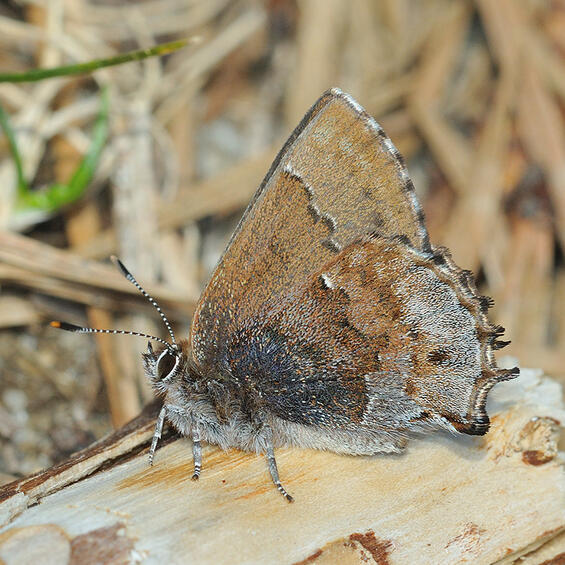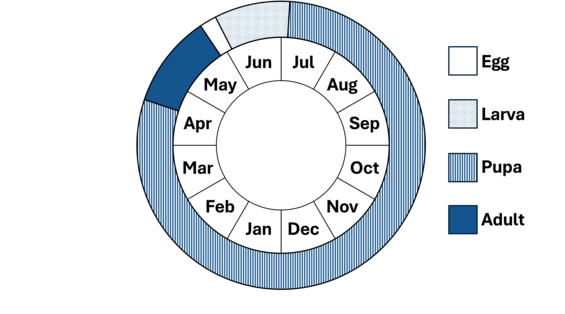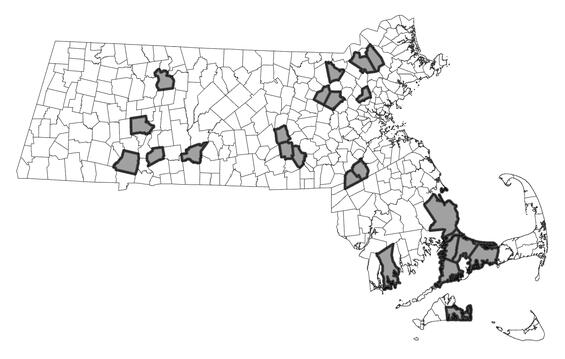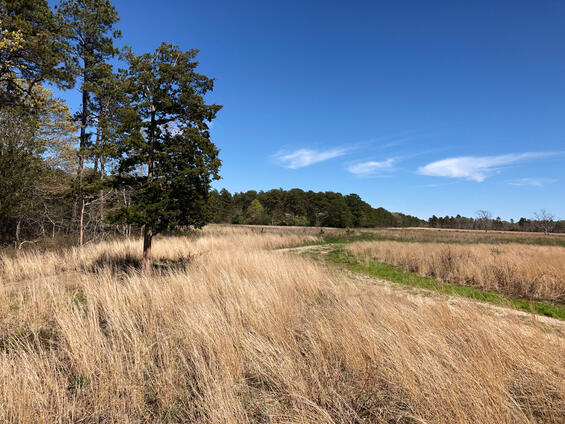- Scientific name: Callophrys irus
- Species of Greatest Conservation Need (MA State Wildlife Action Plan)
- Special Concern (MA Endangered Species Act)
Description

Frosted elfin (Callophrys irus)
The frosted elfin (Callophrys irus) is a lycaenid butterfly with a wingspan of 26-32 mm (1.0-1.3 in; Opler 1998). Like most gossamer-wings, the frosted elfin rests with wings folded above its back. The upper side of the wings, hidden in this position, is uniform dark brown in color. The wings are also brown on the underside, the forewing with a dashed postmedial line outlined with white. The underside of the hind wing is dark brown in the basal area, brown frosted with whitish-gray toward the outer margin. The hind wing has an obscure postmedial line outlined with white, typically most prominently outlined at the costa with a short white dash, sometimes also toward the inner margin. There is a prominent black, submarginal spot above the tail. The frosted elfin is similar to Henry’s elfin (Callophrys henrici); however, the forewing postmedial line of Henry’s elfin is continuous (not dashed). The basal area of the hind wing of Henry’s elfin is darker brown than that of the frosted elfin, and the postmedial line is typically more completely outlined with white; there is usually no black submarginal spot, and when a spot is present it is smaller than that of the frosted elfin. The frosted elfin may also be confused with the hoary elfin (Callophrys polios); however, the underside of the forewing of the hoary elfin has whitish-gray shading along the outer margin, which is absent in the frosted elfin.
Life cycle and behavior

In Massachusetts, adult frosted elfin butterflies fly from late April through late May. Larvae feed on either yellow wild indigo (Baptisia tinctoria) or wild lupine (Lupinus perennis) in June, with all individuals pupating by early July. Pupae overwinter.
Distribution and abundance
The frosted elfin occurs from southern New Hampshire south to northern Florida and west to Wisconsin and eastern Texas, but colonies are rare and localized throughout this range (Schweitzer et al. 2011). In Massachusetts, this species is found in sandplain habitats in the Connecticut River Valley and the eastern part of the state.

Distribution in Massachusetts.
1999-2024
Based on records in the Natural Heritage Database.
Habitat
The frosted elfin inhabits xeric and open, disturbance-dependent habitats on sandy (occasionally rocky) soil, especially grassy/heath openings in pitch pine-scrub oak barrens, but also similar anthropogenic habitats such as utility line rights-of-way, railways, old sand/gravel pits, and airports.
Healthy habitats are vital for supporting native wildlife and plants. Explore habitats and learn about conservation and restoration in Massachusetts.

Sandplain grassland edge with yellow wild indigo, habitat for the frosted elfin butterfly. Habitat managed by MassWildlife at Frances A. Crane Wildlife Management Area.
Threats
The frosted elfin is threatened by habitat loss and fire suppression in its disturbance-dependent habitats, in particular sandplain pitch pine-scrub oak barrens with grassy/heath openings. Fire promotes growth of yellow wild indigo and wild lupine, and maintains the open habitat structure needed by both the frosted elfin and its host plants. Other potential threats include introduced generalist parasitoids, aerial insecticide spraying, non-target herbicide application, excessive deer browse of larval host plants, and off-road vehicles. The effect of a warming climate may not be detrimental to this species in Massachusetts; its range extends south to Florida, suggesting adaptation to warm temperatures.
Conservation
Land protection and habitat management are the primary conservation needs of this species in Massachusetts. In particular, sandplain pitch pine-scrub oak barrens and associated grasslands and heathlands should be conserved, restored, and managed to maintain habitat for this species and the entire suite of rare and threatened species dependent on such habitats.
Survey and monitoring
The distribution of the frosted elfin in sandplain pitch pine-scrub oak barrens is well documented. Known populations of this species should be surveyed to document persistence at least once every 25 years; every 10 years is more desirable when practicable.
Management
Management of sandplain pitch pine-scrub oak barrens and associated grasslands and heathlands benefits a suite of rare and threatened species, and habitat condition should be monitored and management adapted as needed. For the frosted elfin, pine barrens with grassy/heath openings with yellow wild indigo (Baptisia tinctoria) or wild lupine (Lupinus perennis) are of particular importance.
Research needs
The natural history and conservation needs of the frosted elfin are relatively well known. However, the future effects of a warming climate on this species are unpredictable and should be documented.
References
Opler, P.A. 1998. A Field Guide to Eastern Butterflies. Peterson Field Guide Series. Houghton Mifflin, Boston, Massachusetts. 486 pp.
Schweitzer, D.F., M.C. Minno, and D.L. Wagner. 2011. Rare, Declining, and Poorly Known Butterflies and Moths (Lepidoptera) of Forests and Woodlands in the Eastern United States. Forest Service, U.S. Dept. of Agriculture, Washington, DC. 517 pp.
Contact
| Date published: | March 6, 2025 |
|---|